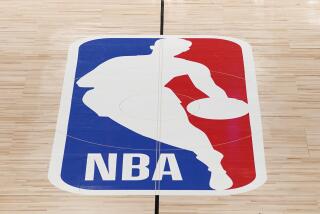NBA LOCKOUT
So long, for a while. . . .
Labor Day came early in the NBA when Commissioner David Stern announced a lockout Monday that starts tonight at midnight, EDT. Thatâs 9 p.m. here, so right after âBuffy the Vampire Slayerâ but before âFrasier,â your NBA will be no more.
If this sounds ominous, it means so little immediately that basketball people are celebrating it as the start of their summer vacations.
Said one general manager, laughing, before Sternâs conference call Monday, âIâve already got my flips-flops on.â
So, without further ado, our guide to the Summer of Labor:
WHAT THIS MEANS
There will be no contact between teams and players for the duration. Teams canât sign players, put them on summer-league teams or work them out.
Three years ago, Stern locked out the players for the first time and shook them up. Agents confided that their clients were startled by letters informing them their medical coverage was terminated and would be continued under the COBRA program.
This time, the players say theyâre prepared.
WHATâS THE TIME FRAME ON THIS MESS?
Stern said Monday it would take about four weeks after an agreement was reached for teams to sign free agents and conduct camps.
They can probably do it in two. Since the season was supposed to open Nov. 1, that suggests mid-October as the first real deadline.
THE STICKING POINT
The league has asked for a hard salary cap, with the Larry Bird exception thrown out.
Since that has been a part of all deals since the cap was introduced in 1984, the union reasonably terms this a âgive-back.â
The league counters in a conciliatory tone, at least in press conferences, that this isnât a give-back, since itâs not seeking to cut the revenue allotted for the players, currently at $1 billion, or about $2.5 million per union member.
The league, however, may be less interested in a hard cap--hard to enforce when guaranteed contracts are the rule--than a mechanism limiting starsâ pay, like the NFLâs âfranchise playerâ designation, which then pays them the average of the top five players at their position.
THE REAL PROBLEM: THE NEW DYNAMIC
While the NFL and baseball took a series of strikes that ran the gamut from â bad PRâ to âruinous,â the NBA avoided trouble because it had to.
Before the onset of prosperity in the â80s, professional basketball was a hand-to-mouth existence and couldnât afford strikes.
The union was battle-tested, having won its spurs in a single action, a threatened strike of the 1964 All-Star game in Boston, led by Tom Heinsohn and Bob Cousy, during which Laker owner Bob Short pounded on the dressing room door, demanding Elgin Baylor and Jerry West come out. Baylor calmed Short down and went back in.
The players got their pension plan and after that, ownership didnât mess with them.
NBA commissioners Walter Kennedy, Larry OâBrien and Stern forged such a good working relationship with union head Larry Fleischer, they were able to take a revolutionary step together with the first salary cap in 1984.
Fleischerâs death, however, left a vacuum at the top of the union. Charles Grantham, who succeeded him, was sacked during the 1995 negotiations for expense-account irregularities. His successor, Simon Gourdine, was not only a former NBA deputy commissioner but politically tone-deaf enough to try an end run around the powerful agentsâ advisory committee.
The agents overturned the deal. Stern gave a little more, Gourdine agreed anew and the agents struck again, trying to decertify the union.
That move failed and the revised deal was adopted but with players grumbling theyâd been run over again.
In fact, it didnât turn out to be an âownersâ dealâ or a âplayersâ dealâ but a âstarsâ dealâ--and the stars and their agents are now in charge. David Falkâs client, Patrick Ewing, is the union president. Attorney Jeff Kessler, who led the decertification drive, is now its counsel.
Stern, who cannot have missed the unionâs hostile turn, is reopening in the sure knowledge that heâs putting the leagueâs 100% labor record in jeopardy. This suggests--and league sources agree--that Stern isnât worried about his old record, and isnât bluffing.
The players insist they arenât, either.
âThereâs not a lot of middle ground now,â said union spokesman Dan Wasserman on Monday from New York.
âIf we agreed to what theyâre asking, the players would throw us out on their butts. The players are not going to give up the Bird exception and the players are not inclined to a hard cap. . . .
âThe league is doing concession bargaining. They expect the players to go to the tables and make concessions because [the owners] are financially hurting. The players arenât buying it. Right now, I think everybody is going to have to get a taste of the lockout.â
MMMM, TASTES GOOD
Stern isnât known for getting himself into things he hasnât thought through.
If recent strikes suggest anything, it was that a league could be forgiven--as the NHL was, by and large--if it took a strike early but salvaged its season and playoffs. If there was one thing to avoid, it was to let a union gain control of the playoffs--as baseball did.
The NBA season is more like the NHLâs than baseballâs or the NFLâs. Baseball has its mythical numerical standards, like 20 wins for a pitcher, or 60 home runs. Football only has 16 games, which are important.
In the winter sports, the NBA and NHL, the regular season is really a glorified warmup.
Moreover, NBA teams will be getting paid--richly--whether they open on time or not. The new TV deal kicks in, raising each teamâs take from $9 million to $22 million annually.
And, according to the new contracts, the TV money will be paid on schedule, labor stoppage or no labor stoppage.
Teams would have to repay the networks later for games missed. However, the fat part of the deal, the NBC money, wonât be jeopardized until the peacockâs first telecast--Christmas Day, seven weeks into the season.
OWNER SOLIDARITY: WHITHER THE DOVES?
There have been reports that several owners--such as the Lakersâ Jerry Buss--donât like the idea of missing games.
Two owners, Portland billionaire Paul Allen and Boston gadfly Paul Gaston, actually voted against locking the players out, a pro forma motion that should have been unanimous.
Since there are more billionaires like Orlandoâs Rich DeVos and Miamiâs Mickey Arison, and more big-market teams like the Knicks, who only want to keep playing so they can turn the handle on their money machine, there seems the possibility of a dove wing.
Stern remains a power, perhaps the last powerful commissioner, so this will be a test for him. Sources suggest heâs still riding tall in the saddle, his owners falling in line behind him, even if some donât like the idea.
Said a source close to Buss, of the Laker owner: âHeâs not delighted. Heâs making so much money. But heâll hold out, if they donât open till next January.â
PLAYER SOLIDARITY: MUSICAL CHAIRS?
Like an army that hasnât had to fight for a while--or in these playersâ cases, in their lifetimes--who knows?
They got off to a good start, getting the young players on the Dream Team, who were eager to play in the World Championships, to let the union call their shot and, if necessary, stay home.
Nevertheless, it was a small, symbolic victory. Nothing will tell on either side until each faces the prospect of personal financial loss.
Stern sits at the head of a well-oiled PR machine and can enforce at least the appearance of solidarity, as he has done before, announcing a $1 million fine for anyone who says something he shouldnât.
The players have interests in common but they also have 400 families to feed. There are 191 free agents. There are 272 players with guaranteed contracts. Even assuming 13 players to a team--most stash someone on the injured list--that leaves only 105 openings.
Thatâs 191 players, eager to find out where, or if, theyâll be playing next season. Thatâs 191 union members who may develop their own agendas.
WHY THE PLAYERSâ CASE IS SHAKY
Their problem isnât the owners. Itâs their own stars, who are taking a disproportionate share of revenues.
Stern has a good talking point when he notes that one solution would be to mail a check for $1 billion to the union and let the players divide it up, themselves.
WHY THE OWNERSâ CASE IS SHAKY
Beware when smooth-talking lawyers like Stern start quoting numbers from books they wonât let you see.
If all those owners are in such dire straits, why do they keep bidding coachesâ pay up and up and up?
Take Gaston, the refusenik who keeps asking why his fellow owners donât just draw a line in the sand the way he does when it comes to paying players those outlandish salaries.
Gaston recently hired Rick Pitino for $8 million a year, by far the most ever paid for a coach in the history of sport.
THE BULLS ANGLE
As any 8-year-old could tell you, keeping Michael Jordan depends on the Chicago Bulls signing Scottie Pippen, which is on hold until they solve the knotty problem of when (if?) the NBA will start the season, and under what rules.
Will Jordan wait it out until the bitter end? He left baseball during its last labor action, angry when White Sox management moved union players out of the major league clubhouse.
Of course, as Stern could tell you, everyone has to go some time.
(BEGIN TEXT OF INFOBOX / INFOGRAPHIC)
THE ISSUES
* SALARY CAP
The current âsoftâ salary cap is $26.9 million per team, which may be exceeded when teams re-sign their own veteran free agents. The owners want to install a âhardâ cap, which could not be exceeded, tied to a designated percentage of basketball-related income.
* LARRY BIRD EXCEPTION
The league wants to eliminate the rule that allows teams to re-sign their own free agents regardless of salary-cap constraints.
* ROOKIE SCALE
All first-round draft choices now must sign three-year guaranteed contracts that cannot be extended until two years have passed. The league has proposed a five-year rookie scale with a right of first refusal for at least one additional year. The union is strongly opposed to longer rookie contracts.
* SHRINKING MIDDLE CLASS
Almost 20% of the players are earning the minimum salary of $272,500, usually because two or three players on each roster are taking up most of the cap space. The players want a salary scale for veterans with increased minimums based upon years in the league.
* DRUG POLICY
Only heroin and cocaine are covered currently. The league would like to add provisions for marijuana and alcohol abuse. The union has resisted changes.
More to Read
Go beyond the scoreboard
Get the latest on L.A.'s teams in the daily Sports Report newsletter.
You may occasionally receive promotional content from the Los Angeles Times.










